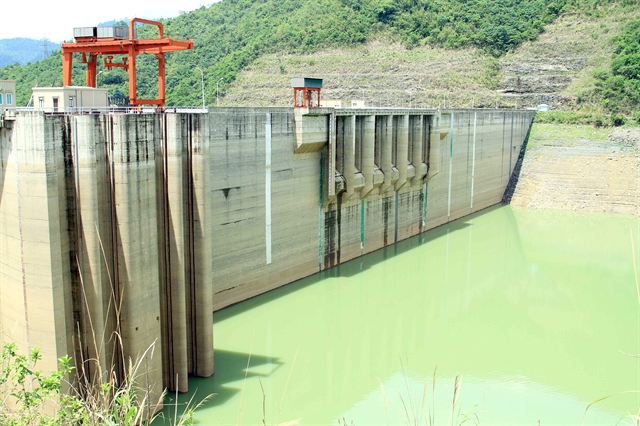Not only playing an important role in the national electricity grid, hydropower plants also contribute to flood prevention and provide water for agriculture, industrial production and daily activities.

Bản Vẽ Hydropower Plant in Nghệ An Province recorded a critically low water level in the summer of 2023. (Photo: Tá Chuyên, VNA/VNS)
While the national water supply is sufficient, experts believe that new measures should be put forward to optimise operations at hydropower plants and regulate flows for daily necessities and energy security, especially amid climate change impacts.
Forecasters warn that water levels at hydroelectric reservoirs will remain low this year, posing challenges to harnessing hydropower during summer.
Vietnam Electricity (EVN) has prepared to balance supply for a nine per cent increase in energy demand compared to 2023.
The company also proposed that the water storing process for the season begin earlier than usual for hydropower plants at river basins in the north. This is to ensure normal water levels in reservoirs.
More supply from thermal power plants has been put into use since the beginning of the year to reserve water for the hot season.
Not only playing an important role in the national electricity grid, hydropower plants also contribute to flood prevention and provide water for agriculture, industrial production and daily activities.
Việt Nam’s total hydropower capacity is 23,595MW according to statistics from 2023.
The flood prevention capacity of reservoirs across the country reaches 15.8 billion cubic metres, of which 15 billion cubic metres are in the north.
Hydropower also makes up 43.6 per cent of the power supply in the region, which means water shortage will directly affect the regional electricity grid.
According to Dr Nguyễn Huy Hoạch from Việt Nam Energy Association, the limited amount of water in hydroelectric reservoirs at the end of the dry season is the result of increasing climate change impacts. Intense heat also causes spikes in power demands.
A report from the National Load Dispatch Centre revealed that in 2023, the total amount of water stored in reservoirs equalled 12.96 billion kWh, which was 2.1 billion kWh lower than the average water level.
Meanwhile, the supply from thermal power plants is insufficient for stable operations.
Several coal-powered plants in the north are running behind schedule such as Na Dương 2, Nam Định 1, An Khánh-Bắc Giang, Vũng Áng 2, Quảng Trạch 1, Đức Giang and Công Thanh, while the Quỳnh Lập 1 power plant project was cancelled.
According to the Electricity Regulatory Authority of Việt Nam, from March 11 to 17, water flows into hydropower reservoirs are still lower than the yearly average.
Reservoirs in the north reported that water flow is currently between 25 and 96 per cent the average of previous years, while 19 out of 27 reservoirs in the central region recorded lower water levels than usual.
The same situation was reported in southern reservoirs, except for Đồng Nai 2, Hàm Thuận and Đa Nhim.
Hà Đăng Sơn, director of the Centre for Energy and Green Growth Research said that optimal operations of hydropower plants, saving water in the dry season and reducing excessive discharges in the rainy season, ensuring a stable power and water supply is the problem of balancing energy security and water sources.
According to Dr Hoạch from the Vietnam Energy Association, in order to ensure stable operations of hydropower plants, it is necessary to look into solutions for appropriate water distribution and regulation in addition to improving water supply forecasts in the near future.
Advanced technology must also be applied to address water shortage and to respond to the negative impacts of weather phenomena, he added.
There are currently multiple limitations in forecasting rainfall and water flows to the reservoirs due to technical constraints, which lead to challenges in saving water.
In the long run, research is necessary to control water flows and usage in accordance with plans on a seasonal, yearly or multi-year basis.
Monitoring systems should also be upgraded for better updates on hydrological data, water flows in rivers and basins, as well as water usage in upstream structures to balance supply for electricity, production and daily necessities.
(VNS)













